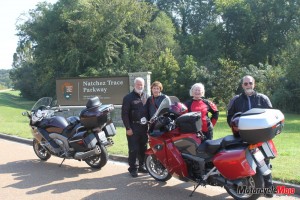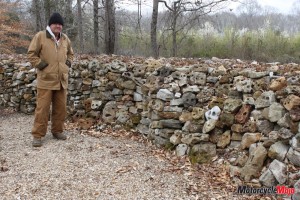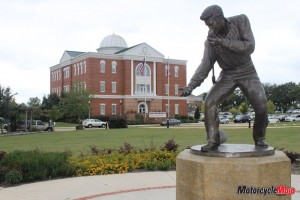The Natchez area holds a fascinating history and some very scenic riding
Tales of cowboys and outlaws come to mind as I relax in the shade of a spreading pecan tree high above the mighty Mississippi and gaze at Louisiana’s distant shore. I daydream of Jim Bowie valiantly defending himself in the 1827 Vidalia sandbar fight that made his knife world-famous. As a lad, the name Natchez was magical, as it was the background for many old Western movies. The Natchez area was a melting pot of American history, and therefore a large part of her identity today.
The long ride from Nashville has placed us at the southern terminus of the Natchez Trace Parkway in Natchez, Mississippi. The French originally called this ancient trail Natchez, after the local native people, and Tracier, meaning pathway. In 1937, after repeated efforts by Congressman Jeff Busby, President Roosevelt funded the construction of the Natchez Trace Parkway as a memorial to its millennia of history. From Natchez to Nashville, no commercial vehicles are permitted along its entire 444 miles.
 My wife, Tina, and I are on a new BMW K1600GTL, and our friends Hank and Marie are on their K1300. We ride cautiously, slipping and sliding, up the gravel laneway, seemingly paved with marbles, and park under the ancient live oaks. Lacy, gray Spanish moss hangs ghostlike from their outstretched limbs, and behind us, the huge white pillars of the antebellum Monmouth Plantation rise majestically. Built in 1818, this was once the home of Major General John Quitman, who served under President Zachary Taylor in the Mexican-American War. A painting in the sitting room portrays Quitman receiving the surrender of the citadel in Mexico City. Today, Monmouth is an elegant Georgian B&B.
My wife, Tina, and I are on a new BMW K1600GTL, and our friends Hank and Marie are on their K1300. We ride cautiously, slipping and sliding, up the gravel laneway, seemingly paved with marbles, and park under the ancient live oaks. Lacy, gray Spanish moss hangs ghostlike from their outstretched limbs, and behind us, the huge white pillars of the antebellum Monmouth Plantation rise majestically. Built in 1818, this was once the home of Major General John Quitman, who served under President Zachary Taylor in the Mexican-American War. A painting in the sitting room portrays Quitman receiving the surrender of the citadel in Mexico City. Today, Monmouth is an elegant Georgian B&B.
Early next morning, a walk around the grounds reveals the opulent flamboyancy of the Old South. Quitman was predictably an avid secessionist, with four plantations and over four hundred slaves.
We mount up and ride slowly into Natchez to the old train station, and take a tour in a horse-drawn buggy. Three hundred years in the making, Natchez has many stories, some embellished I’m sure. We walk through ostentatious Stanton Hall with its five-metre ceilings and beautiful grounds that occupy an entire city block, another example of the ill-gotten gains derived from slavery.
Riding across town, we park our bikes in front of the city’s oldest building, King’s Tavern. In 1779, Richard King built his tavern using salvaged wood from boats left behind by the “Kaintucks.” These were frontiersmen from Kentucky and the Tennessee Valley who poled their goods down the Mississippi to Natchez and New Orleans. Musket holes in the building tell of Indian raids and the lawlessness of the times.
During a 1930s renovation, a brick wall was removed, and inside were found the skeletal remains of Madeline, King’s mistress. Suspicions were that Mrs. King had disposed of Madeline, and the cache hidden in the wall validates the story. Never doubt that “Hell hath no fury like a woman spurned.”Another legend tells of a baby that was killed in King’s Tavern by one of the notorious outlaws of the day. Ever since Madeline’s bones were discovered, a baby’s crying can be heard in an upstairs bedroom during the night.
After a great lunch at Fat Mama’s Tamales, we make our way slowly down the cliff to Natchez Under-the-Hill. Here, fighting, prostitution, robbery and murder were a way of life. Mark Twain once stated, “The only thing here worth less than a woman’s body is a man’s life.” And here the “Cock of the Walk” – the biggest, meanest person – got to wear a red feather in his cap until someone came along who was able to beat him in a fist fight, or kill him, and remove the feather.
 Natchez has also been the set for numerous Hollywood movies, and the last pieces are being pulled together for Get On Up, a movie about the life of James Brown. We wander into the eclectic Pig Out Inn BBQ, and after a huge helping of smoked beef brisket, we mount up and meander through town to Monmouth. It amazes me that this full-sized BMW touring motorcycle is so docile in town, but can rocket us to way over the speed limit in a heartbeat.
Natchez has also been the set for numerous Hollywood movies, and the last pieces are being pulled together for Get On Up, a movie about the life of James Brown. We wander into the eclectic Pig Out Inn BBQ, and after a huge helping of smoked beef brisket, we mount up and meander through town to Monmouth. It amazes me that this full-sized BMW touring motorcycle is so docile in town, but can rocket us to way over the speed limit in a heartbeat.
With memories of Natchez compartmentalized, we pack up and wiggle back and forth down the driveway for the last time. Atop a slight rise on the east side of town stands Forks-of-the-Road, once the largest slave market in Mississippi. With a huge cotton market in Europe, the demand for slaves made men like Isaac Franklin and John Armfield very rich. Slaves purchased cheaply in Virginia and Maryland were kept in the slave pens in Alexandria, Virginia, then they would be driven south on foot along the Natchez Trace. The movie Twelve Years a Slave comes from the diary of one such unfortunate man.
Standing by our bikes at the entrance, we see the Old Trace through the trees. The original trail meandered through Natchez, Chickasaw and Choctaw lands. We begin our ride at a leisurely pace, passing through verdant green woods, skirting pastures and farmland, and we relax as we get into our riding groove. The road surface is excellent, but if you are looking for hard riding or curves, this is not the place. Ambitious law enforcement awaits tourists who want to push the envelope.
A laid-back morning cruise brings us to Milepost 105.6 and the Ross Barnett Reservoir, fifty square miles of water held back by an earthen dam. Paralleling the shoreline, we stop at another of the many waypoints, the Old Cypress Swamp, where an ancient river once flowed. We take a stroll along the boardwalk amongst huge cypress trees that grow out of the algae-covered water, and I wonder what creatures might lurk below the surface.
With miles yet to travel, we mount up again. Clicking through the smooth-shifting gearbox, we head north for our destination, French Camp. Two hundred years ago, a man could get a warm meal and lodgings along the old Natchez Trace at what were called “stands.” In 1812, French Canadian Louis LeFleur moved north from Jackson, Mississippi, and set up his stand, known as French Camp.
Missionaries set up a school here for native children in 1818. The French Camp Academy, now sitting on nine hundred acres of Mississippi wilderness, accepts students of any race or culture who pay what they can afford for tuition, and almost two hundred children from grades one to twelve live and work here.
We ride slowly past a horse-operated sorghum mill and stop at the Thrift Shop to check in. For the next two nights, and our only day of rain, our digs will be a beautiful, historic log home. We wander along the raised boardwalk to the Council House Café for a “Big Willie,” a house specialty, followed by a generous helping of Mississippi Mud Cake. The Council House Café was the original council house of the Choctaw native chiefs and elders.
The morning brings gray sky and cool air, but the rain has stopped. At Milepost 193.1, we terrace uphill through the live oaks and pines to the top of Little Mountain. It is not really a mountain, but in flat Mississippi, we can see for miles.
Idling back down to the Trace, we tool along, enjoying a few gentle curves as we pass through farmland and forest – and the occasional signs of destruction from earlier tornadoes. Trees snapped off like twigs show the force of nature’s angry moments. Occasionally, we find ourselves completely surrounded by tunnels of trees with Spanish moss hanging gray and limp in the morning dew. It’s an easygoing ride, with no trucks and very few cars.
 The miles click off, and soon we arrive at the Tupelo Hardware Company store. I strike up a conversation with an older gentleman behind the counter, and he invites me to stand on an X marked on the well-worn hardwood floor. He begins to tell me a story of a lady and her little boy, who came to the store in 1946 and talked to the clerk. The lady wanted to buy a bicycle for her son’s ninth birthday, but when the boy saw a gun hanging on display, he wanted that instead. After much discussion, they agreed to purchase a $7.75 guitar instead. That boy was Elvis Presley, and I am standing right where he stood 68 years ago.
The miles click off, and soon we arrive at the Tupelo Hardware Company store. I strike up a conversation with an older gentleman behind the counter, and he invites me to stand on an X marked on the well-worn hardwood floor. He begins to tell me a story of a lady and her little boy, who came to the store in 1946 and talked to the clerk. The lady wanted to buy a bicycle for her son’s ninth birthday, but when the boy saw a gun hanging on display, he wanted that instead. After much discussion, they agreed to purchase a $7.75 guitar instead. That boy was Elvis Presley, and I am standing right where he stood 68 years ago.
After a ride through town, we arrive at the Tupelo Automobile Museum, a private collection of over one hundred antique cars valued at over six million dollars. The late Frank Kyle Spain, noted inventor, engineer and the man who brought colour to NBC Television, travelled the world to put this collection together. Cars like an 1886 Benz, a Tucker, a Hispano Suiza, a Duesenberg, and a Lincoln owned by Elvis Presley have us gape-mouthed.
After a unique lunch at Kermit’s Outlaw Kitchen, we walk down the street to Tupelo City Hall and Tupelo Fairpark. Once the Tupelo Fairgrounds, this park is now a shrine to the King, Tupelo’s most famous citizen. A monument depicting Elvis on stage, and various information boards, keep us busy. Here is where, after learning how to play the guitar from his pastor, Elvis won third place in the Tupelo Fair singing contest at age ten.
We wind our way up the hill to an evening at Elvis Presley Park, and we walk through the tiny home where Elvis lived with his mother and father. I am amazed by the abject poverty of Elvis’s roots. Vernon Presley built the 450-square-foot home, which consisted of a kitchen and a bedroom. Elvis slept between his parents, and when he was older, on the floor at the foot of their bed.
Church was a big part of Elvis’s life. The church that the Presleys attended was moved to the park, and the collection of memorabilia is astounding inside the Elvis Presley Museum. After dinner, Memphis Jones entertains us as he takes us down the historic path of the progression from delta blues to the rock music we have today. As a personal friend of many famous writers and musicians, Memphis Jones provides us with an evening filled with insights into southern musical history. Next morning dawns crisp and cool as we leave Tupelo. Riding north to Milepost 286.7, I pull over and peer through the morning mist at the Pharr Mounds. Numerous early native burial mounds can be found along the Trace. Natives buried their dead along with their belongings in these sacred places. At Pharr Mounds, there are eight burial mounds that are estimated to have been created between 1 and 200 AD. Now and then, moderate elevation changes and some pleasant curves in the road tell us that the Appalachians are nearby.
Suddenly, rolling out of the woods, we cross a bridge in the middle of nowhere, and far below, sailboats ply the Tenn-Tom Waterway, a 375 km canal built to link commercial navigation from the heart of America to the Gulf of Mexico. As the road slopes downward, we see the mighty Tennessee River ahead, and we take a side road down to the river’s edge, where Colbert’s Ferry once operated. Legend has it that old George Colbert charged Andrew Jackson $75,000 to ferry his army across on one of his military excursions south. Jackson followed the Old Trace a few times in his conquest of the native tribes, and also to meet the British in New Orleans in the War of 1812. Unknowingly, we have passed many unmarked graves of soldiers who died along the way. News travelled slowly in those days, and the Treaty of Ghent – which ended the War of 1812 – was signed over two weeks before Jackson had his famous battle in New Orleans.
At milepost 385.9, about 70 miles south of Nashville, is Grinder’s Stand, where on October 11, 1809, the body of Meriwether Lewis, of Lewis and Clark fame, was found dead from gunshot wounds. The controversy continues over whether he was murdered or committed suicide. From here on, the Trace begins to wind and fun begins. The Trace carries a maximum speed limit of 50 miles per hour (80 km/h), and that is plenty of speed for the curves on this road. Long, sweeping lefts and rights make for a great end to our ride along one of America’s most historic trails. Franklin, Tennessee, is our final stop for dinner and some street music at a local festival. It’s dark by the time we leave, and we wind along the foothills to our friend’s home. Unloading our bikes in the dark, we bask in the memories of a great journey through some of America’s unique and wild history.








































